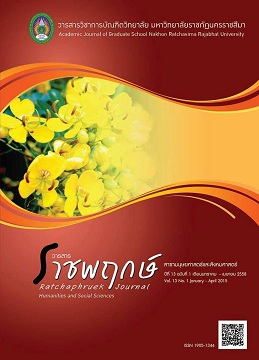Development of English Instructional Model for Communication of Lower Secondary School Students
Main Article Content
Abstract
The objectives of this research were to 1) study language communicative ability factors, 2) develop a communicative language instructional model, and3) studythe effects of a communicative language instructional model. The research procedure consisted of 3 phases: Phase 1, study about language communicative ability factors. A group of samples used in this study were 400 ninth grade students in Lop Buri province. The instruments used in this study were interviews and questionnaires with a reliability of 0.96 were used in statistical data analysis, Phase 2, develop a communicative language instructional model. The model developed is appropriate and contained its feasibility to be used in developing the communicative ability and Phase 3, studythe effects of a communicative language instructional model. The experimental research methodology was conducted by using the time-series research design.
The samples of this research were 60 ninth grade students of Winitsuksa School in Lopburi province. Simple random sampling was used to divide students into 2 groups, 30 students equally in control and experimental groups. The data were collected by the English language communication test and satisfaction in the teaching of English to enhance the communication skills of students.
The statistics used for data analysis were mean, standard deviation, and statistics, one-way analysis of variance with repeated measures (Repeated Measures One-Way ANOVA).
The results were as follows:
1. The confirmatory factor of language communicative ability consisted of 5 components as follows: 1) grammatical competence, 2) sociolinguistic competence, 3) discourse competence, 4) strategic competence, and 5) meta-cognitive competence. The validity of the analysis can be represented by the IOC, and Chi - Square was 191.398.
2. The communicative language instructional model was developed. The teaching has 5 stages: 1) warm-up, 2) presentation, 3) practice, 4) self-assessment and production, and 5) the English language communication test and satisfaction in the teaching of English.
3. The experiment group showed higher scores than the control group at a statistically significant .05 level (F=893.27) and the communicative language instructional model was at the highest level of satisfaction.
Article Details
References
กระทรวงศึกษาธิการ. กรมวิชาการ. (2544). คู่มือพัฒนาสู่การเรียนรู้. กรุงเทพฯ : คุรุสภาลาดพร้าว.
กัลย์ชลากรณ์ มหาพัฒนไทย. (2548). ผลการจัดการเรียนรู้แบบเน้นงานปฏิบัติ ที่มีต่อความสามารถในการใช้ภาษาเพื่อการสื่อสารของนักเรียนชั้นมัธยมศึกษาปีที่ 4 โรงเรียนธนบุรีเทพลีลารักษ์ เขตธนบุรี. ปริญญานิพนธ์ศิลปศาสตรมหาบัณฑิต สาขาการสอนภาษาอังกฤษในฐานะภาษาต่างประเทศ บัณฑิตวิทยาลัย มหาวิทยาลัยศรีนครินทรวิโรฒ.
จิตติวรรณ อินทรผล. (2549). การพัฒนากิจกรรมการเรียนรู้วิชาภาษาอังกฤษของนักเรียนช่วงชั้นที่ 2 [ชั้นประถมศึกษาปีที่ 6] โดยใช้วิธีสอนตามแนวการสอนภาษาเพื่อการสื่อสาร. ขอนแก่น : มหาวิทยาลัยขอนแก่น.
ชินณเพ็ญ รัตนวงศ์. (2547). ผลของการสอนโดยใช้งานปฏิบัติเป็นฐานในการเรียนรู้ ที่มีต่อความสามารถในการใช้ภาษาอังกฤษเพื่อการสื่อสารของนักเรียน ชั้นมัธยมศึกษาปีที่ 6. วิทยานิพนธ์ครุศาสตรมหาบัณฑิต สาขาหลักสูตรและการสอน บัณฑิตวิทยาลัย จุฬาลงกรณ์มหาวิทยาลัย.
ทองใบ ทองภูบาล. (2553). การพัฒนาความสามารถในการพูดภาษาอังกฤษเพื่อการสื่อสารของนักเรียนชั้นมัธยมศึกษาปีที่ 3 โดยการจัดการเรียนรู้แบบเน้นงานปฏิบัติ. ปริญญานิพนธ์ศิลปศาสตรมหาบัณฑิต สาขาการสอนภาษาอังกฤษในฐานะภาษาต่างประเทศ บัณฑิตวิทยาลัย มหาวิทยาลัยศรีนครินทรวิโรฒ.
ปัญจพร อะโนดาษ. (2547). การเปรียบเทียบผลการใช้บทบาทสมมติ และการใช้กรณีตัวอย่าง เพื่อพัฒนาพฤติกรรมการสื่อสารของนักเรียนชั้นมัธยมศึกษาปีที่ 5 โรงเรียนวัดสุนทรพิชิตาราม อำเภอองครักษ์ จังหวัดนครนายก. ปริญญานิพนธ์การศึกษามหาบัณฑิต สาขาวิชาจิตวิทยาการศึกษา บัณฑิตวิทยาลัย มหาวิทยาลัยศรีนครินทรวิโรฒ.
สุพา แสงพรม. (2545). การเปรียบเทียบผลของการใช้บทบาทสมมติและการใช้กรณีตัวอย่างที่มีต่อความฉลาดทางอารมณ์ของนักเรียนชั้นประถมศึกษาปีที่ 5 โรงเรียนวัดจันทรสโมสร. ปริญญานิพนธ์การศึกษามหาบัณฑิต สาขาวิชาจิตวิทยาการศึกษา บัณฑิตวิทยาลัย มหาวิทยาลัยศรีนครินทรวิโรฒ.
อุไรวรรณ แซ่อ๋อ. (2553). การจัดการเรียนรู้แบบเน้นงานปฏิบัติและกิจกรรมกลุ่ม เพื่อพัฒนาความสามารถด้านการพูดภาษาอังกฤษเพื่อการสื่อสารของนักเรียนชั้นมัธยมศึกษาปีที่ 4. ปริญญานิพนธ์ศิลปศาสตรมหาบัณฑิต สาขาการสอนภาษาอังกฤษในฐานะภาษาต่างประเทศ บัณฑิตวิทยาลัย มหาวิทยาลัยศรีนครินทรวิโรฒ.
Johnson, K. (1994). Five Principles in a communicative exercise type in K. Johnson. Communicative syllabus Design and Methodology. Oxford : Pergamon.
Larsen-Freeman, D. (2000). Techniques and Principles in Language Teaching. 2nd ed. Oxford : Oxford University.
Littlewood, W. (1983). Communicative Language Teaching : An Introduction. Cambridge : Cambridge University.
Pica, Teresa and others (1993). “Choosing and using communication tasks for Second instruction and research.” In Graham, Crooks and Susan M. Gass, eds. Tasks and Language Learning : Integrating theory and practice. pp. 18. Bristol : Longdunn.


